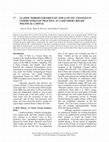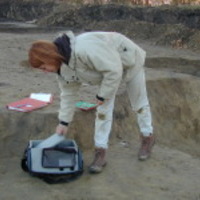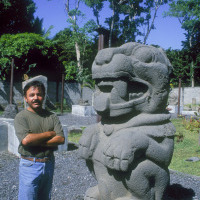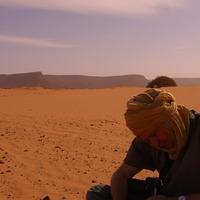Papers by Luke Stroth
The 86th Annual Meeting of the Society for American Archaeology, 2021

Research Reports in Belizean Archaeology , 2023
Figurines are small, portable pieces of art that were popular in the ancient Maya world. Typicall... more Figurines are small, portable pieces of art that were popular in the ancient Maya world. Typically made of fired clay, they portray individual humans, animals, and mythic beings in an assortment of poses and scenes. We report the results of an iconographic analysis of 215 whole and fragmentary figurines excavated in the last 20 years at three Late Classic period sites in the southern Belize region: Nim li Punit, Pusilha, and Lubaantun. Although Early Classic figurines were often modeled, the Late Classic saw a shift to mold-made figurines. This allowed higher levels of production and the repetition of certain motifs. The study of this dataset contributes to our understanding of household activities, gender, and social roles. Together, these collections reveal strong interest in everyday women's work, warfare, and, especially, athletic ritual. The widespread distribution of figurines and the range of subjects they display provide an opportunity to view Maya life from the perspectives of commoners and elites, and from the mundane to the supernatural. We argue that figurines in the Southern Belize Region were more heavily focused on public spectacles of ritual as opposed to private domestic rituals.

Research Reports in Belizean Archaeology, 2023
Pottery recovered from 2012 to 2019 at Nim li Punit, Toledo District, demonstrates that it was oc... more Pottery recovered from 2012 to 2019 at Nim li Punit, Toledo District, demonstrates that it was occupied from AD 150/250 to AD 830+. We identify long-term changes in the kinds of material produced, used, and discarded over the 600- to 700-year occupation of the site. During the last century of the Classic period, Nim li Punit witnessed a decline in the diversity of ceramic practice. This could reflect a shift in feasting behavior, perhaps due to the political and demographic instability experienced throughout Maya lowlands during the eighth century. Alternatively, this could be the result of new networks of alliance and exchange that arose during this turbulent time. A third possibility is that distinct communities of potters occupied Nim li Punit at different times. To test these different interpretations, we track changes in the ceramic collection at the type: variety level. We discuss similarities and differences seen in the pottery of Nim li Punit and that of other political centers of the Southern Belize Region, and note design and style elements that are shared with other parts of the Maya world.

“And in Length of Days Understanding” (Job 12:12): Essays on Archaeology in the Eastern Mediterranean and Beyond in Honor of Thomas E. Levy, 2023
In this chapter we present the results of a paleobotanical analysis of Khirbat al-Jariya, an Iron... more In this chapter we present the results of a paleobotanical analysis of Khirbat al-Jariya, an Iron-Age (ca. eleventh to tenth centuries BCE) copper smelting workshop in Faynan, Jordan. The macrobotanical collection was dominated by easily procured fruits and nuts that required little preparation, such as dates (Phoenix dactylifera), grapes (Vitis sp.) and figs (Ficus sp.) which we characterize as likely “snack foods.” Evidence for grain processing, in terms of cleaning and removal of chaff, is largely absent, and there is no meaningful spatial patterning to the discard of food debris. This suggests that food consumption was a casual process at Khirbat al-Jariya and that food products requiring preparation were processed elsewhere. Comparing this data to that of contemporary sites indicates that this dominance of snack foods is particular to the Faynan region. It is possible that Khirbat al-Jariya was only seasonally occupied, under which circumstances a practice of casual snacking supplemented by prepared foods from elsewhere was sustainable. This complicates the typical binary of “consumer” and “producer,” and we argue that such distinctions may be as much a result of sampling strategies and spatial patterning. We also evaluate how sampling strategies played a role in interpreting the data from Khirbat al-Jariya, which may represent the casual snacking behavior associated with an itinerant industrial community rather than the full spectrum of subsistence during the Iron Age of the Wadi Faynan. Although all societies are some combination of producer and consumer, we argue that the inhabitants of Khirbat al-Jariya were much closer to the consumer end of the spectrum based on both positive evidence for the dominance of snack foods and the negative evidence for food preparation. Their diet consisted of convenient, although seasonal, snack foods, for which the archaeological signal is high, and prepared foods that have not preserved, for which the archaeological signature for local production is almost negligible.
Members of the Toledo Regional Interaction Project and its precursor, the Pusilha Archaeological ... more Members of the Toledo Regional Interaction Project and its precursor, the Pusilha Archaeological Project, have been investigating the major ancient Maya sites of the southern Belize region since 2001. We have conducted mapping operations, test-pitting, and extensive and intensive structural excavations at Pusilha, Lubaantun, and Nim li Punit. We present here the results of the 2018 field season at Nim li Punit. During this season, we excavated and consolidated two platforms: Structures 6 and 7a. We also discuss the innovative ways we have used photogrammetry to document the contexts and artifacts we excavate.

A Proposal for the Standardized Reporting of Error and Paradata Regarding Structure from Motion (SfM) 3D Models Used in Recording and Consolidating Archaeological Architecture, 2020
Please email for full text; In the past decade, archaeologists have increasingly made use of phot... more Please email for full text; In the past decade, archaeologists have increasingly made use of photogrammetry, the process of creating 3D models from photographs, in a variety of field and lab settings. We argue that we must, as a discipline, develop a consistent methodology to ensure that 3D models are held to a consistent standard, including not only photographic protocol but also the documentation of model accuracy using an agreed-upon measure. To help develop this discussion, we present our system for incorporating photogrammetry into the documentation of architecture. This technique was developed at the site of Nim Li Punit, Belize, in 2018. Excavating architecture involves documenting the pre-excavated building, liberating overburden, documenting all in situ construction (including wall fall, fill stones, and standing architecture), drawing consolidated architecture, and documenting the final state of the post-excavated buildings. The generation of 3D models greatly assisted in all facets of the excavation, documentation, analysis, and consolidation processes. To ensure that our models were accurate, we documented the reprojection error and final model horizontal distortion to assess the quality of the model. We suggest that documenting both forms of error should become standard practice in any discussion of archaeological applications of photogrammetry.
Please email for full text
Our goal is to describe how statistical methods impact source assignments made from pXRF data. Th... more Our goal is to describe how statistical methods impact source assignments made from pXRF data. This discussion of the typological and technological analysis of the sample is therefore quite brief. The collection from Guadalupe consists of 355 obsidian artifacts. Almost all (n = 350) are assigned to the prismatic blade industry, including 341 prismatic blade fragments, three typical Postclassic projectile points made by retouching prismatic blade fragments, a single exhausted prismatic blade core (Güinope obsidian), and four casual percussion flakes and one bipolar flake made from recycled exhausted blade cores. One of these flakes was initially sourced by pXRF to the Otumba source in Mexico. Five other artifacts are a small chunk used as a bipolar core, two bipolar flakes, and two casual flakes.
Site Reports by Luke Stroth
Book Reviews by Luke Stroth











Uploads
Papers by Luke Stroth
Site Reports by Luke Stroth
Book Reviews by Luke Stroth